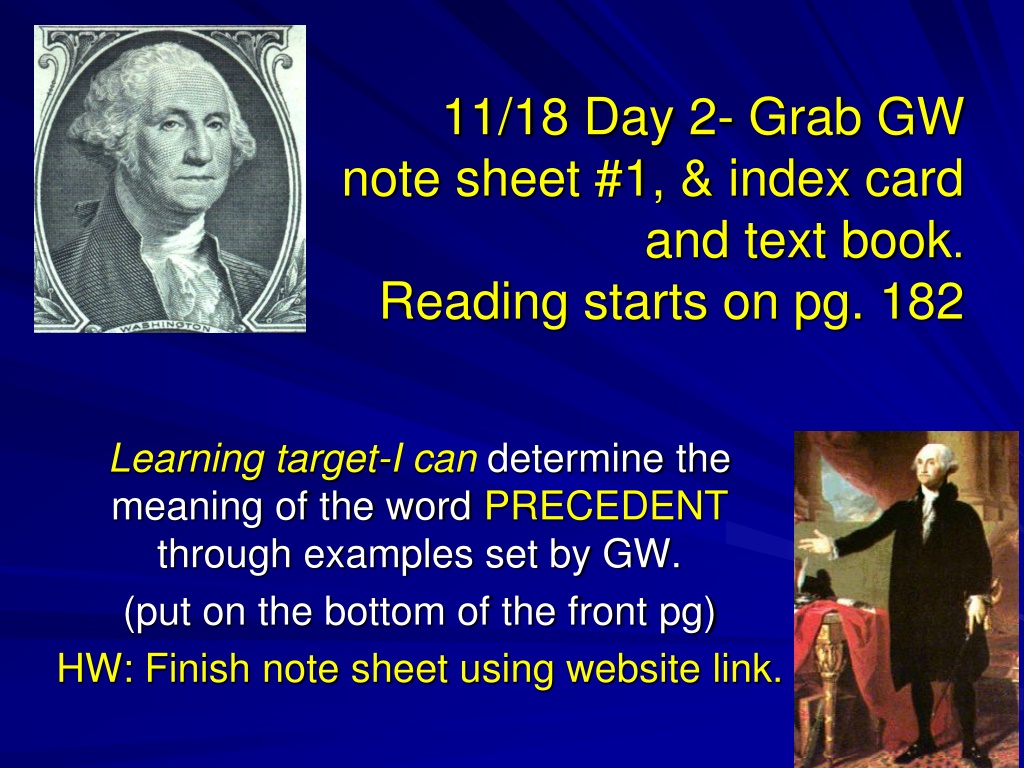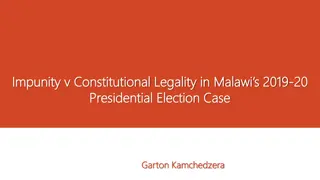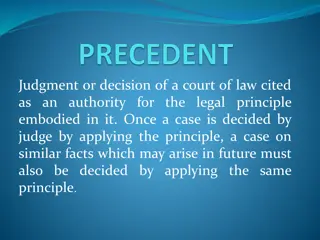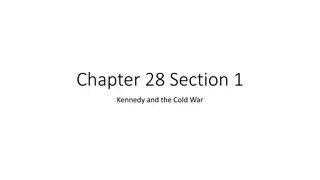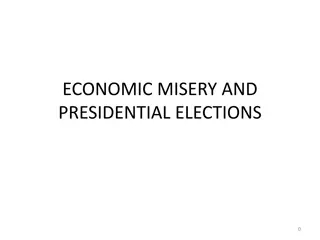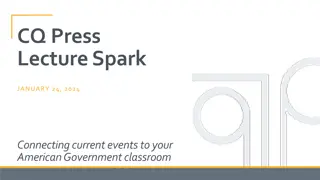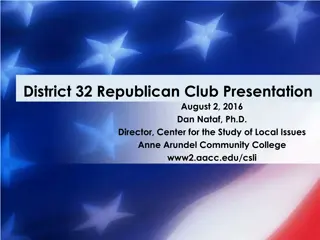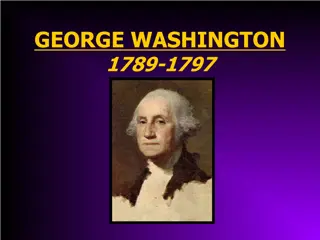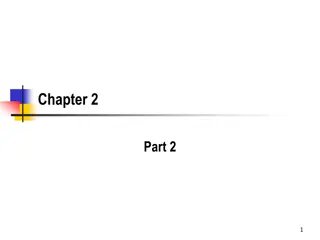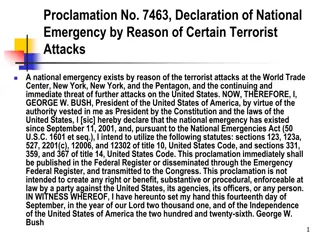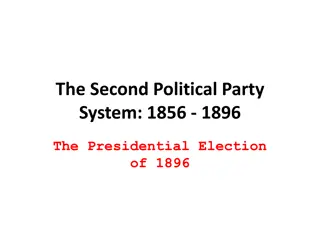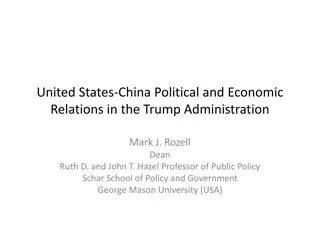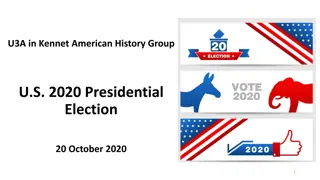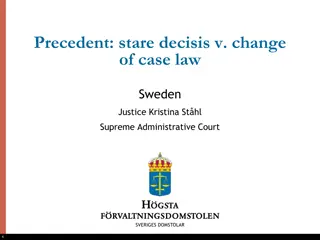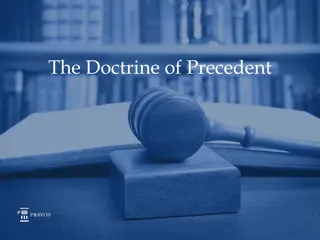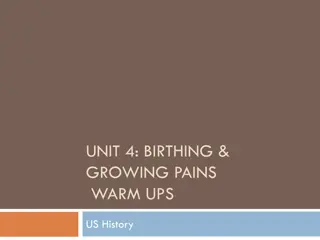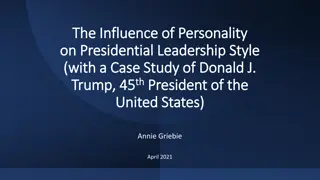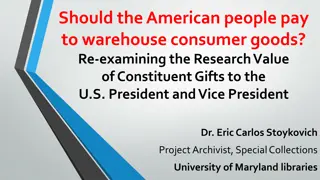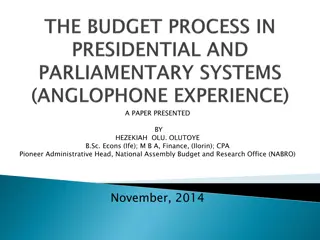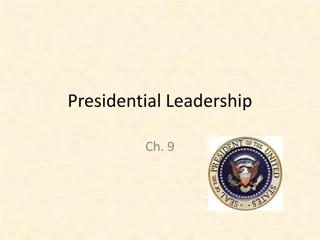Understanding Presidential Precedents in US History
Learn about the concept of presidential precedents through the pioneering actions of George Washington as the first President of the United States in 1789. Explore how these precedents, such as the Judiciary Act of 1789 and the Unwritten Constitution, have shaped the functioning of the US government. Gain insights into Washington's acts, the creation of the first cabinet, and key decisions that set the foundation for future administrations.
Download Presentation

Please find below an Image/Link to download the presentation.
The content on the website is provided AS IS for your information and personal use only. It may not be sold, licensed, or shared on other websites without obtaining consent from the author. Download presentation by click this link. If you encounter any issues during the download, it is possible that the publisher has removed the file from their server.
E N D
Presentation Transcript
11/18 Day 2- Grab GW note sheet #1, & index card and text book. Reading starts on pg. 182 Learning target-I can determine the meaning of the word PRECEDENT through examples set by GW. (put on the bottom of the front pg) HW: Finish note sheet using website link.
Look at your test grade- on a index card tell us why you got this grade. EX: Didn t study, didn t review my notes, didn t read carefully, I don t recall learning this info, absent for some of the material, difficult wording of the questions, unfamiliar terms. How many minutes did you study? Presidents Series
From the dvd, The Presidents As a result of the election of 1789, George Washington was unanimously chosen to be the first president, and John Adams becomes Vice President.
From dvd The Presidents Presidential precedent (Example, Model) Washington s first precedent was that he added so help me God to the oath of office He also asked to be called Mr. President Another important precedent was that he left office after two terms
Washingtons Acts and Precedencies Judiciary Act of 1789 Federal Courts would hear cases involving Constitutional issues: illegal search and seizure, freedom of Speech, cruel and unusual punishment Appeal to US Circuit Court of Appeals.
The Judiciary Act of 1789 US Supreme Court Can choose not to hear Case! Judge makes the decision Circuit Court Appeals US Jury decides Case US District Courts 13 Courts
The Unwritten Constitution The operation of the U.S. Government today is based on many precedents,customs, traditions and practices that were not written into the Constitution. Cabinet Political Parties Lobbying Committee System Judicial Review Unwritten
1. The First Cabinet - ency0091 The Constitution gave the President the power to appoint people to assist him. Article II, Section II. Secretary of State Jefferson Secretary of Justice Edmond Randolph Secretary of War Henry Knox Secretary of Treasury Alexander Hamilton
To the Executive Branch Washington added 3 executive departments or advisers known as the Cabinet. Thomas Jefferson Secretary of State Alexander Hamilton Secretary of the Treasury Henry Knox Secretary of War Edmund Randolph was the attorney general or chief lawyer of the federal government
2. Political Parties An organized group that runs candidates to win elections, and influence policy.
4. Lobbying Pressure groups and outside influences that attempt to influence legislation, or urge legislators to pass certain laws. home home home NRA-PVF atm_logo_new
5. Committee System Committees help Congress select the most important bills from the thousands proposed yearly. They hold hearings to discuss, evaluate and approve bills.
Whiskey Rebellion To pay off the national debt, Hamilton pushes Congress to pass a PROTECTIVE TARIFF- (tax on imports) and an EXCISE TAX (Sin Tax)on whiskey. Pennsylvania farmers rebel, Washington and a militia put down the rebellion and showed that the new government was ready to enforce the laws.
Results Hamilton convinces President Washington and Congress that because of the ELASTIC CLAUSE, necessary and proper clause, the bank is constitutional. The Bank of the United States is established to issue paper money and handle government debt. Construction on a new capital building in Washington D.C. begins (old one was in NYC).
A Nation Divided A Two (2) Party Political System forms Two opposing IDEOLOGIES-beliefs, ideas or perspectives. The FEDERALIST V. DEMOCRATIC- REPUBLICAN
The Federalist Democratic Republicans VS -Alexander Hamilton -Thomas Jefferson -Strong Central Gov t -State Rights- -Loose Interpretation of the Constitution -National Bank needed -No National Bank -Elitist Wealthy and educated should rule citizens- equal access -Strict Interpretation -Egalitarian-farmer
Foreign Policy In 1789, the French Revolution begins By 1793, the Revolution has grown radical & war spreads across Europe. Some Americans want to support the French, and some want to support the British. In 1793, Washington issues a Proclamation of Neutrality saying that the U.S. will stay out of European entanglements 1795 Pinckney s Treaty gives U.S. any Spanish land claims east of Mississippi R. (except Florida) and use of Mississippi R. and port of New Orleans Jay s Treaty avoided a war with British, but many Americans unhappy with terms.
Washington bids farewell Goodbye G.W! In his farewell address Washington warns the nation: to steer clear of permanent alliances with other nations Against spirit of the party (political parties)
1796 Election from textbook R p.194, B p. 180 Federalist John Adams becomes President Democratic-Republican Thomas Jefferson becomes VP Almost all of the electors from the southern states voted for Jefferson and the northern electors voted for Adams This showed SECTIONALISM placing the interests of region ahead of the whole nation- pride in ones region, http://www.270towin.com/
11/19 Day 3- Take out Washington notes #1, lets review. Grab Guided Reading #2 and text p.184-185 Learning Target: I can . examine the differences between Jefferson and Hamilton and explain how these differences may have impacted our new nation.
Hamilton vs. Jefferson Closely read pg. 184-185 Decide which person or party you would agree with and on the sticky note write why, put it on the board under the name. NOW read Hamilton s and Jefferson s letters. Work with your group to answer the Guided Reading questions. Alexander Hamilton
11/20 Day 4- Put your flip cards in the HW box w/NAME, take out pg. 2- Guided Reading. Grab Washington s Farewell Address #3. Learning Target: examine the differences between Jefferson and Hamilton and explain how these differences may have impacted our new nation. Whiskey Rebellion HOMEWORK: TEST CORRECTIONS Due Monday
Guided Readings Quickly review you notes Hamilton and Jefferson or read pg 184 -185. Read Hamilton s and Jefferson s Letters to President Washington. Complete the Guided Reading Q s with your group. Change your sticky note if you need. Let s Discuss.
11/23 Day 5 Take out #2 GR and #3 Farewell Address. Put test corrections in HW box. Let discuss Hamilton & Jefferson and Farewell. Learning Target: I can explain the significance of George Washington s Farewell Address. (write on the back of pg 3) Whiskey Rebellion
